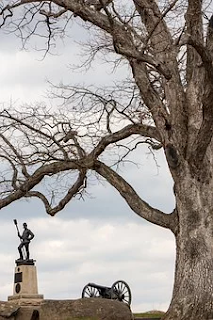Rethinking the "Both Sides" Reflex
by Dr. Bonnie Laughlin-Schultz, Illinois Civics Instructional Coach
How often do we in American life talk about the need to represent both sides? I saw an intriguing interview last week in which a Congressperson complained to a member of the media that they were being unfair by not presenting “both sides.” We critique headlines, we talk of the silos in which we receive our news, and we discuss the importance of preparing our students to be smart consumers of media. But I confess, even with our good intentions I think at times we are led astray into thinking that presenting “both sides” is the best path towards objectivity and better news habits.
One example concerns the discussion of Confederate monuments. It might be tempting to set up an exercise in which students debate if monuments should be removed, with a reading representing “remain” and another posturing “remove.”
This feels neutral; we choose readings from two sides, structure student reading, and help them reach informed decisions, right? But are these both sides we as social studies teachers should represent? Or do we need to attend to nuance in this discussion, making sure to provide readings that accurately present the history of monument building and, moreover, to take into account the many possibilities that exist if monuments are removed?
A few years ago I read a memoir by Mitch Landrieu, former mayor of New Orleans who oversaw the removal of four monuments there. He spent a book outlining his and the nation’s history and thinking about the background and presence of the monuments in his city. His thinking is nuanced as well as a great example for students of how to mull and arrive at an informed opinion. He gave a famous speech on the topic, too, and that could be great to use. This is not to imply that his is the only right position; rather, it is to say that his is a position steeped in an understanding of the history of the monuments and thoughtful in consideration of their place in American life today.
Isn’t this what we really want our students to be doing? Asking students to carefully examine his opinion alongside three pieces: a news article about the specific sides in New Orleans, a progressive mayor calling for monuments to stand, and a writer highlighting African American protest against them takes thinking about “both sides” up a notch and is at the heart of an Illinois Civics lesson plan.
Note that an uninformed, knee-jerk “keep them” position is not reflected here, nor is this a Fox-versus-MSNBC-and-you-decide approach. Though some of the pieces offer compelling arguments of why they should stay, they are all nuanced in their reflection, deep in consideration of the issues involved in thoughtful consideration of the place of monuments in the United States, past and present.
In our classrooms, we are not just battling against fake news. We are fighting for nuance and careful attention to facts. I love the News Literacy Project’s bumper sticker: “Facts are democracy’s seat belt.” But it’s not just “facts” alone, it is nuanced consideration of issues in American life.
Bonnie Laughlin-Schultz taught high school in the St. Louis area prior to earning a PhD in history. She was a James Madison fellow, class of 1999, and graduated from Knox College with a BA in history and secondary education. She is the social science teaching coordinator and an associate professor of history at Eastern Illinois University, where she teaches social studies methods courses as well as the U.S. history survey, women’s history, research methods and writing, and courses in the online MA for teachers. She is the Civics Instructional Coach for Clark, Clay, Coles, Crawford, Cumberland, Douglas, Edgar, Edwards, Gallatin, Hamilton, Hardin, Jasper, Lawrence, Massac, Moultrie, Pope, Richland, Saline, Shelby, Wabash, Wayne & White Counties.





Comments
Post a Comment